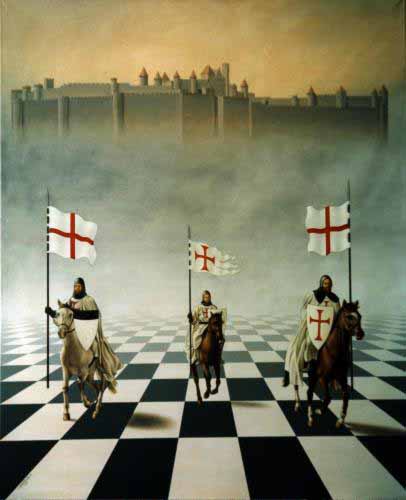

The Poor Fellow-Soldiers of Christ and of the Temple of Solomon (Latin: Pauperes commilitones Christi Templique Solomonici), commonly known as the Knights Templar, the Order of the Temple (French: Ordre du Temple or Templiers) or simply as Templars, were among the most famous of the Western Christian military orders. The organization existed for approximately two centuries in the Middle Ages.
Officially endorsed by the Roman Catholic Church around 1129, the Order became a favored charity throughout Christendom, and grew rapidly in membership and power. Templar knights, in their distinctive white mantles with a red cross, were among the most skilled fighting units of the Crusades. Non-combatant members of the Order managed a large economic infrastructure throughout Christendom, innovating financial techniques that were an early form of banking, and building many fortifications across Europe and the Holy Land.
The Templars' existence was tied closely to the Crusades; when the Holy Land was lost, support for the Order faded. Rumors about the Templars' secret initiation ceremony created mistrust, and King Philip IV of France, deeply in debt to the Order, took advantage of the situation. In 1307, many of the Order's members in France were arrested, tortured into giving false confessions, and then burned at the stake. Under pressure from King Philip, Pope Clement V disbanded the Order in 1312. The abrupt disappearance of a major part of the European infrastructure gave rise to speculation and legends, which have kept the "Templar" name alive into the modern day.
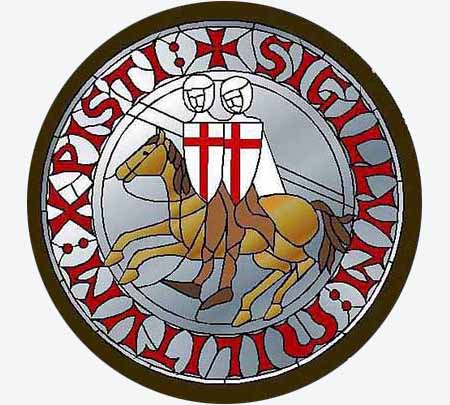
The Master of the Knights Templar's great seal was double-sided and showed the picture of The Dome of the Rock (some opinions are that the picture represents a circular dome of the Church of the Holy Sepulchre) on one side and the Order's symbol of two knights on one horse on the other side. There was also a smaller, single-sided seal, which showed the Dome of the Rock (or the circular dome of the Holy Sepulchre). Every Grand Master seal shares distinctive characteristics. In order to avoid misuse, special measures were taken regarding the seals. They were kept in a locked compartment which required three keys to open. The Grand Master himself kept one of these keys, and two of his high officials held the others. The forgery of the seals was a very difficult process because each seal was unique and hand made.
The Templars were organized as a monastic order similar to Bernard's Cistercian Order, which was considered the first effective international organization in Europe. The organizational structure had a strong chain of authority. Each country with a major Templar presence (France, England, Aragon, Portugal, Poitou, Apulia, Jerusalem, Tripoli, Antioch, Anjou, Hungary, and Croatia) had a Master of the Order for the Templars in that region. All of them were subject to the Grand Master, appointed for life, who oversaw both the Order's military efforts in the East and their financial holdings in the West. No precise numbers exist, but it is estimated that at the Order's peak there were between 15,000 and 20,000 Templars, of whom about a tenth were actual knights.
It was Bernard de Clairvaux and founder Hugues de Payens who devised the specific code of behavior for the Templar Order, known to modern historians as the Latin Rule. Its 72 clauses defined the ideal behavior for the Knights, such as the types of garments they were to wear and how many horses they could have. Knights were to take their meals in silence, eat meat no more than three times per week, and not have physical contact of any kind with women, even members of their own family.
A Master of the Order was assigned "4 horses, and one chaplain-brother and one clerk with three horses, and one sergeant brother with two horses, and one gentleman valet to carry his shield and lance, with one horse." As the Order grew, more guidelines were added, and the original list of 72 clauses was expanded to several hundred in its final form.
There was a threefold division of the ranks of the Templars: the aristocratic knights, the lower-born sergeants, and the clergy. Knights were required to be of knightly descent and to wear white mantles. They were equipped as heavy cavalry, with three or four horses and one or two squires. Squires were generally not members of the Order but were instead outsiders who were hired for a set period of time. Beneath the knights in the Order and drawn from lower social strata were the sergeants. They were either equipped as light cavalry with a single horse or served in other ways such as administering the property of the Order or performing menial tasks and trades. Chaplains, constituting a third Templar class, were ordained priests who saw to the Templars' spiritual needs.
The knights wore a white surcoat with a red cross and a white mantle; the sergeants wore a black tunic with a red cross on front and back and a black or brown mantle. The white mantle was assigned to the Templars at the Council of Troyes in 1129, and the cross was most probably added to their robes at the launch of the Second Crusade in 1147, when Pope Eugenius III, King Louis VII of France, and many other notables attended a meeting of the French Templars at their headquarters near Paris. According to their Rule, the knights were to wear the white mantle at all times, even being forbidden to eat or drink unless they were wearing it.
Initiation, known as Reception (receptio) into the Order, was a profound commitment and involved a solemn ceremony. Outsiders were discouraged from attending the ceremony, which aroused the suspicions of medieval inquisitors during the later trials.
New members had to willingly sign over all of their wealth and goods to the Order and take vows of poverty, chastity, piety, and obedience. Most brothers joined for life, although some were allowed to join for a set period. Sometimes a married man was allowed to join if he had his wife's permission, but he was not allowed to wear the white mantle.
The red cross that the Templars wore on their robes was a symbol of martyrdom, and to die in combat was considered a great honor that assured a place in heaven. There was a cardinal rule that the warriors of the Order should never surrender unless the Templar flag had fallen, and even then they were first to try to regroup with another of the Christian orders, such as that of the Hospitallers.
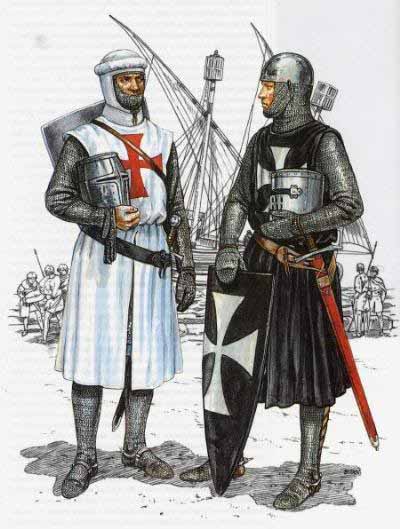
Only after all flags had fallen were they allowed to leave the battlefield. This uncompromising principle, along with their reputation for courage, excellent training, and heavy armament, made the Templars one of the most feared combat forces in medieval times.
After the First Crusade captured Jerusalem in 1099, many Christian pilgrims traveled to visit what they referred to as the Holy Places. However, though the city of Jerusalem was under relatively secure control, the rest of the Outremer was not. Bandits abounded, and pilgrims were routinely slaughtered, sometimes by the hundreds, as they attempted to make the journey from the coastline at Jaffa into the Holy Land.
Around 1119, two veterans of the First Crusade, the French knight Hugues de Payens and his relative Godfrey de Saint-Omer, proposed the creation of a monastic order for the protection of these pilgrims. King Baldwin II of Jerusalem agreed to their request, and gave them space for a headquarters on the Temple Mount, in the captured Al Aqsa Mosque. The Temple Mount had a mystique, because it was above what was believed to be the ruins of the Temple of Solomon. The Crusaders therefore referred to the Al Aqsa Mosque as Solomon's Temple, and it was from this location that the Order took the name of Poor Knights of Christ and the Temple of Solomon, or "Templar" knights. The Order, with about nine knights, had few financial resources and relied on donations to survive. Their emblem was of two knights riding on a single horse, emphasizing the Order's poverty.
The Templars' impoverished status did not last long. They had a powerful advocate in Saint Bernard of Clairvaux, a leading Church figure and a nephew of André de Montbard. He spoke and wrote persuasively on their behalf, and in 1129 at the Council of Troyes, the Order was officially endorsed by the Church. With this formal blessing, the Templars became a favored charity throughout Christendom, receiving money, land, businesses, and noble-born sons from families who were eager to help with the fight in the Holy Land. Another major benefit came in 1139, when Pope Innocent II's papal bull Omne Datum Optimum exempted the Order from obedience to local laws. This ruling meant that the Templars could pass freely through all borders, were not required to pay any taxes, and were exempt from all authority except that of the Pope.
With its clear mission and ample resources, the Order grew rapidly. Templars were often the advance force in key battles of the Crusades, as the heavily armoured knights on their warhorses would set out to charge at the enemy, in an attempt to break opposition lines. One of their most famous victories was in 1177 during the Battle of Montgisard, where some 500 Templar knights helped to defeat Saladin's army of more than 26,000 soldiers.
Although the primary mission of the Order was military, relatively few members were combatants. The others acted in support positions to assist the knights and to manage the financial infrastructure. The Templar Order, though its members were sworn to individual poverty, was given control of wealth beyond direct donations. A nobleman who was interested in participating in the Crusades might place all his assets under Templar management while he was away.
Accumulating wealth in this manner throughout Christendom and the Outremer, the Order in 1150 began generating letters of credit for pilgrims journeying to the Holy Land: pilgrims deposited their valuables with a local Templar preceptory before embarking, received a document indicating the value of their deposit, then used that document upon arrival in the Holy Land to retrieve their funds. This innovative arrangement was an early form of banking, and may have been the first formal system to support the use of cheques; it improved the safety of pilgrims by making them less attractive targets for thieves, and also contributed to the Templar coffers.
Based on this mix of donations and business dealing, the Templars established financial networks across the whole of Christendom. They acquired large tracts of land, both in Europe and the Middle East; they bought and managed farms and vineyards; they built churches and castles; they were involved in manufacturing, import and export; they had their own fleet of ships; and at one point they even owned the entire island of Cyprus. The Order of the Knights Templar arguably qualifies as the world's first multinational corporation.
In the mid-12th century, the tide began to turn in the Crusades. The Muslim world had become more united under effective leaders such as Saladin, and dissension arose among Christian factions in and concerning the Holy Land.
The Knights Templar were occasionally at odds with the two other Christian military orders, the Knights Hospitaller and the Teutonic Knights, and decades of internecine feuds weakened Christian positions, politically and militarily.
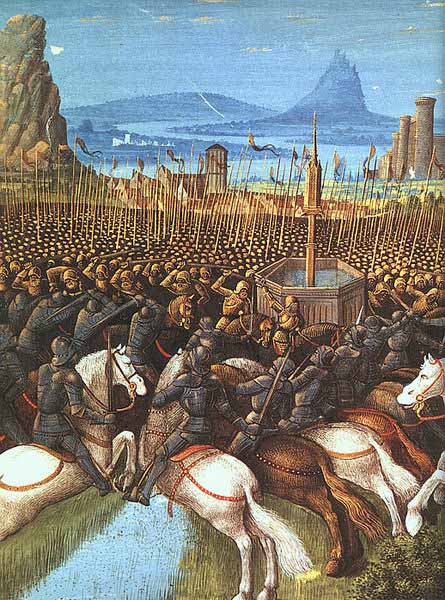
After the Templars were involved in several unsuccessful campaigns, including the pivotal Battle of the Horns of Hattin, Jerusalem was captured by Saladin's forces in 1187. The Crusaders retook the city in 1229, without Templar aid, but held it only briefly.
In 1244, the Khwarezmi Turks recaptured Jerusalem, and the city did not return to Western control until 1917 when the British captured it from the Ottoman Turks.
The Templars were forced to relocate their headquarters to other cities in the north, such as the seaport of Acre, which they held for the next century. But they lost that, too, in 1291, followed by their last mainland strongholds, Tortosa (in what is now Syria), and Atlit. Their headquarters then moved to Limassol on the island of Cyprus, and they also attempted to maintain a garrison on tiny Arwad Island, just off the coast from Tortosa.
In 1300, there was some attempt to engage in coordinated military efforts with the Mongols via a new invasion force at Arwad. In 1302 or 1303, however, the Templars lost the island to the Egyptian Mamluks in the Siege of Arwad. With the island gone, the Crusaders lost their last foothold in the Holy Land.
With the Order's military mission now less important, support for the organization began to dwindle. The situation was complex though, as over the two hundred years of their existence, the Templars had become a part of daily life throughout Christendom.
The organization's Templar Houses, hundreds of which were dotted throughout Europe and the Near East, gave them a widespread presence at the local level. The Templars still managed many businesses, and many Europeans had daily contact with the Templar network, such as by working at a Templar farm or vineyard, or using the Order as a bank in which to store personal valuables.
The Order was still not subject to local government, making it everywhere a "state within a state" - its standing army, though it no longer had a well-defined mission, could pass freely through all borders. This situation heightened tensions with some European nobility, especially as the Templars were indicating an interest in founding their own monastic state, just as the Teutonic Knights had done in Prussia and the Knights Hospitaller were doing with Rhodes.
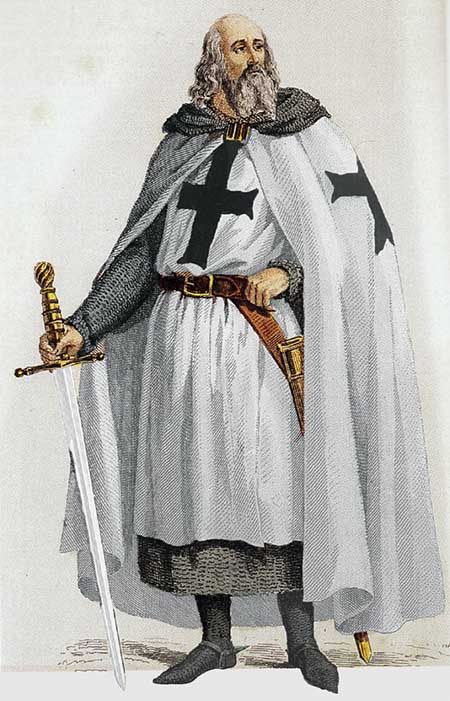
In 1305, the new Pope Clement V, based in France, sent letters to both the Templar Grand Master Jacques de Molay and the Hospitaller Grand Master Fulk de Villaret to discuss the possibility of merging the two Orders. Neither was amenable to the idea, but Pope Clement persisted, and in 1306 he invited both Grand Masters to France to discuss the matter. De Molay arrived first in early 1307, but de Villaret was delayed for several months. While waiting, De Molay and Clement discussed charges that had been made two years prior by an ousted Templar.
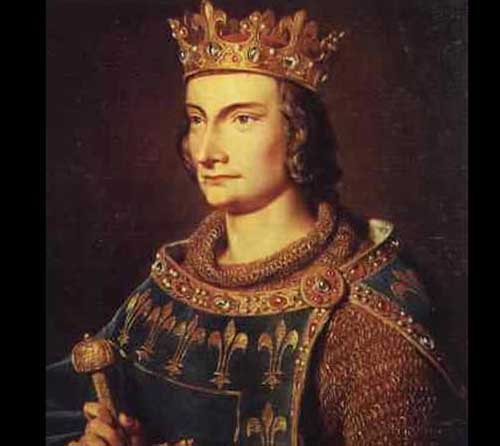
It was generally agreed that the charges were false, but Clement sent King Philip IV of France a written request for assistance in the investigation. King Philip was already deeply in debt to the Templars from his war with the English and decided to seize upon the rumors for his own purposes. He began pressuring the Church to take action against the Order, as a way of freeing himself from his debts.
On Friday, October 13, 1307 (a date sometimes linked with the origin of the Friday the 13th superstition) Philip ordered de Molay and scores of other French Templars to be simultaneously arrested. The arrest warrant started with the phrase : "Dieu n'est pas content, nous avons des ennemis de la foi dans le Royaume" (free translation " God is not pleased. We have enemies of the faith in the kingdom").
The Templars were charged with numerous offences (including apostasy, idolatry, heresy, obscene rituals and homosexuality, financial corruption and fraud, and secrecy).
Many of the accused confessed to these charges under torture, and these confessions, even though obtained under duress, caused a scandal in Paris. All interrogations were recorded on a thirty meter long parchment, kept at the "Archives nationales" in Paris. The prisoners were coerced to confess that they had spat on the Cross : "Moi Raymond de La FŹre, 21 ans, reconnais que (J'ai) craché trois fois sur la Croix, mais de bouche et pas de coeur" (free translation : "I, Raymond de La FŹre, 21 years old, admit that I have spit three times on the Cross, but only from my mouth and not from my heart". The Templars were accused of idolatry. The parchment mentions a red, monochromatic image of a man on linen or cotton, qualified as an idol by the interrogators.
This suggests the presence of the Shroud of Turin.
In 1307 few people knew of its whereabouts. After the sack of Constantinople by the Fourth Crusade in 1204, the Shroud, that had been in the possession of the Emperor, disappeared for about one century. It reappeared in the small town of Lirey, in the Champagne region of France around the years 1353 to 1357 in the possession of Geoffroy de Charny and later in Chambéry in the possession of the Duke of Savoy.
After more bullying from Philip, Pope Clement then issued the papal bull Pastoralis Praeeminentiae on November 22, 1307, which instructed all Christian monarchs in Europe to arrest all Templars and seize their assets.
Pope Clement called for papal hearings to determine the Templars' guilt or innocence, and once freed of the Inquisitors' torture, many Templars recanted their confessions. Some had sufficient legal experience to defend themselves in the trials, but in 1310 Philip blocked this attempt, using the previously forced confessions to have dozens of Templars burned at the stake in Paris.
Convent of Christ in Castle Tomar, Portugal. Built in 1160 as a stronghold for the Knights Templar, it became the headquarters of the renamed Order of Christ. In 1983, it was named a UNESCO World Heritage Site.
With Philip threatening military action unless the Pope complied with his wishes, Pope Clement finally agreed to disband the Order, citing the public scandal that had been generated by the confessions. At the Council of Vienne in 1312, he issued a series of papal bulls, including Vox in excelso, which officially dissolved the Order, and Ad providam, which turned over most Templar assets to the Hospitallers.
As for the leaders of the Order, the elderly Grand Master Jacques de Molay, who had confessed under torture, retracted his statement. His associate Geoffrey de Charney, Preceptor of Normandy, followed de Molay's example and insisted on his innocence.
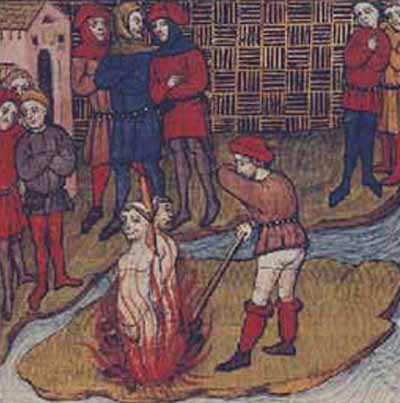
Both men were declared guilty of being relapsed heretics, and they were sentenced to burn alive at the stake in Paris on March 18, 1314. De Molay reportedly remained defiant to the end, asking to be tied in such a way that he could face the Notre Dame Cathedral and hold his hands together in prayer.
According to legend, he called out from the flames that both Pope Clement and King Philip would soon meet him before God. His actual words were recorded on the parchment as follows : "Dieu sait qui a tort et a pĎché. Il va bientot arriver malheur ą ceux qui nous ont condamnés ą mort" (free translation : "God knows who is wrong and has sinned. Soon a calamity will occur to those who have condemned us to death").
Pope Clement died only a month later, and King Philip died in a hunting accident before the end of the year.
With the last of the Order's leaders gone, the remaining Templars around Europe were either arrested and tried under the Papal investigation (with virtually none convicted), absorbed into other military orders such as the Knights Hospitaller, or pensioned and allowed to live out their days peacefully. Some may have fled to other territories outside Papal control, such as excommunicated Scotland or to Switzerland. Templar organizations in Portugal simply changed their name, from Knights Templar to Knights of Christ - see Order of Christ (Portugal).
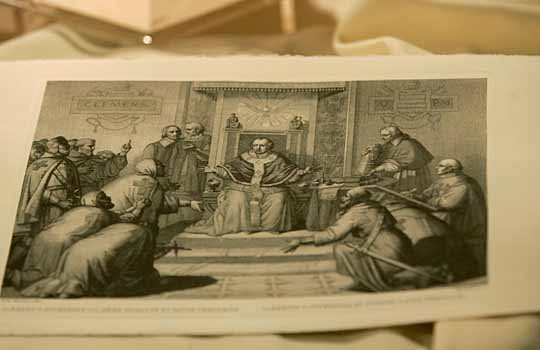
In 2001, a document known as the Chinon Parchment was found in the Vatican Secret Archives, apparently after having been filed in the wrong place in 1628. It is a record of the trial of the Templars and shows that Clement absolved the Templars of all heresies in 1308 before formally disbanding the Order in 1312.
It is currently the Roman Catholic Church position that the medieval persecution of the Knights Templar was unjust; that there was nothing inherently wrong with the Order or its Rule; and that Pope Clement was pressured into his actions by the magnitude of the public scandal and the dominating influence of King Philip IV.
Legacy
Distinctive architectural elements of Templar buildings include the use of the image of "two knights on a single horse", representing the Knights' poverty, and round buildings designed to resemble the Church of the Holy Sepulchre in Jerusalem.
By papal decree, the property of the Templars was transferred to the Order of Hospitallers, which also absorbed many of the Templars' members. In effect, the dissolution of the Templars could be seen as the merger of the two rival orders.
The story of the secretive yet powerful medieval Templars, especially their persecution and sudden dissolution, has been a tempting source for many other groups which have used alleged connections with the Templars as a way of enhancing their own image and mystery.
Since at least the 18th century the Freemasons have incorporated some Templar symbols and rituals, most of which being found within a Masonic body referred to as the United Religious, Military and Masonic Orders of the Temple and of St John of Jerusalem, Palestine, Rhodes and Malta, or simply the Knights Templar. This organization exists either independently or as a part of the York Rite throughout much of the world. The Sovereign Military Order of the Temple of Jerusalem, founded in 1804, has achieved United Nations NGO status as a charitable organization.
There is no clear historical link between the Knights Templar, which were dismantled in the 14th century, and any of these other organizations, of which the earliest emerged publicly in the 18th century. However, there is often public confusion and many overlook the 400-year gap. There are many self-styled orders.
The Knights Templar have become associated with legends concerning secrets and mysteries handed down to the select from ancient times. Rumors circulated even during the time of the Templars themselves.
Freemason writers added their own speculations in the 19th century, and further fictional embellishments have been added in popular novels such as Ivanhoe, Foucault's Pendulum, and The Da Vinci Code, modern movies such as National Treasure and Indiana Jones and the Last Crusade, as well as video games such as Broken Sword, and Assassin's Creed.
Many of the Templar legends are connected with the Order's early occupation of the Temple Mount in Jerusalem and speculation about what relics the Templars may have found there, such as the Holy Grail or the Ark of the Covenant.
That the Templars were in possession of some relics is certain. Many churches still display holy relics such as the bones of a saint, a scrap of cloth once worn by a holy man, or the skull of a martyr; the Templars did the same. They were documented as having a piece of the True Cross, which the Bishop of Acre carried into battle at the disastrous Horns of Hattin. When the battle was lost, Saladin captured the relic, which was then ransomed back to the Crusaders when the Muslims surrendered the city of Acre in 1191.
The Templars were known to possess the head of Saint Euphemia of Chalcedon. The subject of relics also came up during the Inquisition of the Templars, as several trial documents refer to the worship of an idol of some type, referred to in some cases as a cat, a bearded head, or in some cases as Baphomet. This accusation of idol worship levied against the Templars has also led to the modern belief by some that the Templars practiced witchcraft. However, modern scholars generally explain the name Baphomet from the trial documents as simply a French misspelling of the name Mahomet (Muhammad).
The Holy Grail quickly became associated with the Templars, even in the 12th century. The first Grail romance, the Le Conte du Graal, was written around 1180 by Chrétien de Troyes. Perhaps twenty years later Parzival, Wolfram von Eschenbach's version of the tale, refers to knights called "Templeisen" guarding the Grail Kingdom.
Another hero of the Grail quest, Sir Galahad (a 13th-century literary invention of monks from St. Bernard's Cistercian Order) was depicted bearing a shield with the cross of Saint George, similar to the Templars' insignia: this version presented the "Holy" Grail as a Christian relic. However, in the extensive documents of the Templar inquisition there was never a single mention of anything like a Grail relic, let alone its possession by the Templars. In reality, most scholars agree that the story of the Grail was just that, a fiction that began circulating in medieval times.
One legendary object that does have some connection with the Templars is the Shroud of Turin. In 1357, the shroud was first publicly displayed by the family of the grandson of Geoffrey de Charney, the Templar who had been burned at the stake with Jacques de Molay in 1314. The shroud's origins are still a matter of controversy, but in 1988, a carbon dating analysis concluded that the shroud was made between 1260 and 1390, a span that includes the last half-century of the Templars' existence. The validity of the dating methodology has subsequently been called into question, and the age of the shroud is still subject of much debate. Read more
Archaeologists discover 800-year-old 'treasure tunnels' built in Israel by the Knights Templar Christian warriors Daily Mail - October 23, 2019
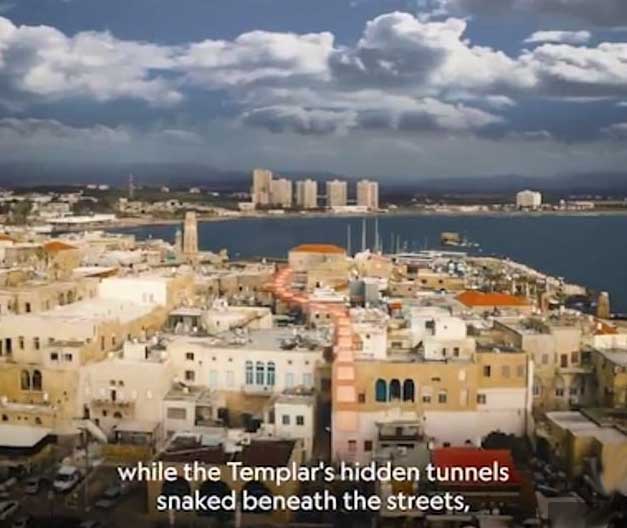
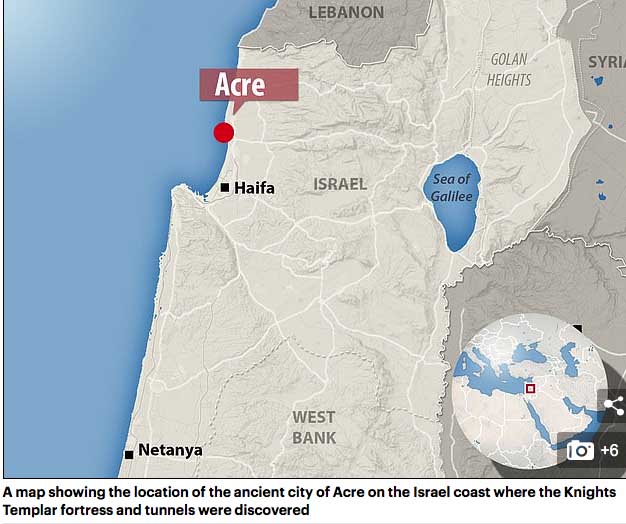
The secrets of the Knights Templar have been unearthed by archaeologists in Israel. A set of 'lost' tunnels leading to a treasure tower were discovered, which the legendary warrior monks would have used to transport their gold around 800 years ago. Remnants of the soldiers' extravagant headquarters was also uncovered in the ancient city of Acre, on the coast of Israel.
The hidden world of the Knights Templar: Stunning images show mysterious carvings etched into a Hertfordshire cave by warrior monks 800 years ago Daily Mail - April 24, 2017
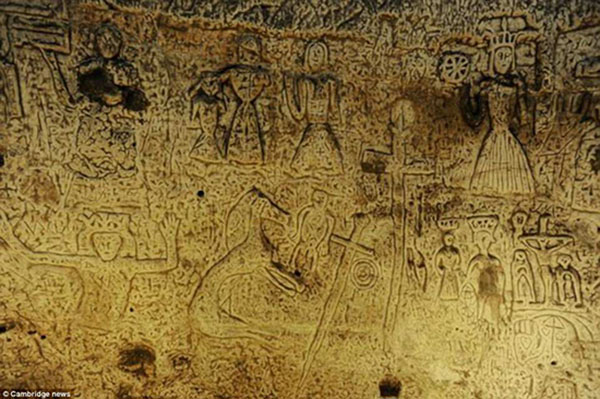
Stunning 800-year-old carvings have been found inside a Knights Templar cave under a crossroads in a small English town. The carvings appear to show pictures of four patron saints as well as scenes with John the Baptist and Mary, the mother of Jesus. The ancient cave was once used by the same religious order that fought in the Crusades and were made famous by the popular Dan Brown book The Da Vinci Code.
The Origin of the Knights Templar - Descendants of Jewish Elders? Ancient Origins - December 31, 2015
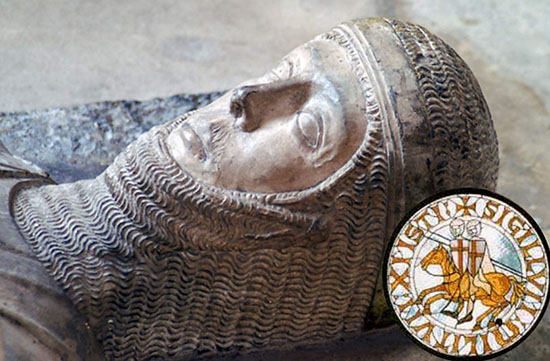
The Knights Templar initially arrived in the Holy Land on a mission to reclaim some treasure that they believed was rightfully theirs. According to the modern Templar historians, Tim Wallace-Murphy and Christopher Knight, the knights who banded together as the Knights Templar were part of a wave of European royalty descended from Jewish Elders that had fled the Holy Land around 70 AD, when it was invaded by the Romans. Before leaving their homeland, these Elders had hidden their temple treasures and priceless Essene and Kabbalistic scrolls in strategic regions of the Holy Land so that the Roman invader Titus could not plunder them as the spoils of war. The Jewish Elders then immigrated to Europe. There, many of them married into the continent's noble families. Of these Elders, twenty-four would become the patriarchs of a group of European families known by the sobriquet of the Rex Deus or Star families.
AOL - October 13, 2007
The Knights Templar, the medieval Christian military order accused of heresy and sexual misconduct, will soon be partly rehabilitated when the Vatican publishes trial documents it had closely guarded for 700 years. A reproduction of the minutes of trials against the Templars, "'Processus Contra Templarios -- Papal Inquiry into the Trial of the Templars"' is a massive work and much more than a book. "This is a milestone because it is the first time that these documents are being released by the Vatican, which gives a stamp of authority to the entire project. Nothing before this offered scholars original documents of the trials of the Templars", said Professor Barbara Frale, a medievalist at the Vatican's Secret Archives. 799 numbered copies of the work have been made.
One parchment measuring about half a meter wide by some two meters long is so detailed that it includes reproductions of stains and imperfections seen on the originals. Pope Benedict will be given the first set of the work, published by the Vatican Secret Archives in collaboration with Italy's Scrinium cultural foundation, which acted as curator and will have exclusive world distribution rights.
The Templars, whose full name was "Poor Fellow-Soldiers of Christ and of the Temple of Solomon," were founded in 1119 by knights sworn to protecting Christian pilgrims visiting the Holy Land after the Crusaders captured Jerusalem in 1099. They amassed enormous wealth and helped finance wars of some European monarchs. Legends of their hidden treasures, secret rituals and power have figured over the years in films and bestsellers such as "The Da Vinci Code." The Knights have also been portrayed as guardians of the legendary Holy Grail, the cup used by Christ at the Last Supper before his crucifixion. The Vatican expects most copies of the work to be bought up by specialized libraries at top universities and by leading medieval scholars.
The Templars went into decline after Muslims re-conquered the Holy Land at the end of the 13th century and were accused of heresy by Philip IV of France - Philip The Fair, their foremost persecutor. Their alleged offences included denying Christ and secretly worshipping idols. The most titillating part of the documents is the so-called Chinon Parchment, which contains phrases in which Pope Clement V absolves the Templars of charges of heresy, which had been the backbone of King Philip's attempts to eliminate them. Templars were burned at the stake for heresy by King Philip's agents after they made confessions that most historians believe were given under duress.
The parchment, also known as the Chinon Chart or Parchment, was "misplaced" in the Vatican archives until 2001, when Frale stumbled across it. "The parchment was catalogued incorrectly at some point in history. At first I couldn't believe my eyes. I was incredulous," she said. "This was the document that a lot of historians were looking for," the 37-year-old scholar said. Philip was heavily indebted to the Templars, who had helped him finance his wars, and getting rid of them was a convenient way of cancelling his debts, some historians say. Frale said Pope Clement was convinced that while the Templars had committed some grave sins, they were not heretics.
Their initiation ceremony is believed to have included spitting on the cross, but Frale said they justified this as a ritual of obedience in preparation for possible capture by Muslims. They were also said to have practiced sodomy. "Simply put, the pope recognized that they were not heretics but guilty of many other minor crimes -- such as abuses, violence and sinful acts within the order. But that is not the same as heresy," Frale said.
Despite his conviction that the Templars were not guilty of heresy, in 1312 Pope Clement ordered the Templars disbanded for what Frale called "the good of the Church" following his repeated clashes with the French king. Frale depicted the trials against the Templars between 1307 and 1312 as a battle of political wills between Clement and Philip, and said the document means Clement's position has to be reappraised by historians. "This will allow anyone to see what is actually in documents like these and deflate legends that are in vogue these days," she said.
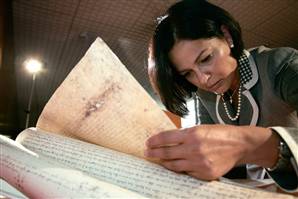
Rosi Fontana, who has helped the Vatican coordinate the project, said, "The most incredible thing is that 700 years have passed and people are still fascinated by all of this. The precise reproduction of the parchments will allow scholars to study them, touch them, admire them as if they were dealing with the real thing. But even better, it means the originals will not deteriorate as fast as they would if they were constantly being viewed."
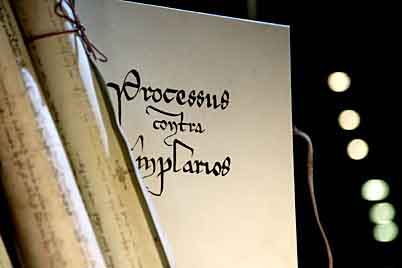
The Vatican Secret Archives is publishing 799 copies of a document
that was found in 2001 after being lost for centuries.
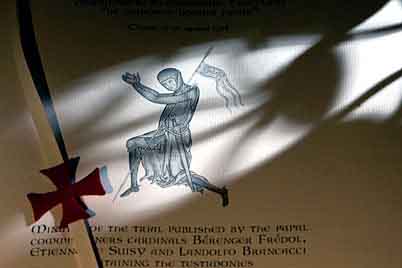
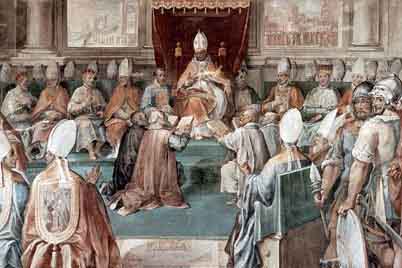
The document suggests that Pope Clement V, depicted above in a painting,
did not think the Knights were guilty of heresy, but felt pressure from
the French King and ordered the group to disband.
The photos on AOL end with connections to the bloodline
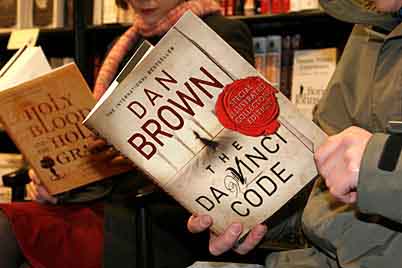
Scotsman.com - May 20, 2005
1398 and the fleet sails from Orkney on a voyage funded by the Templars to the New World. On board are Prince Henry Sinclair, Lord of Rosslyn, and the Zeno brothers, renowned Venetian sailors.
One hundred years before Christopher Columbus discovered America they reached Nova Scotia where Templar architecture and the oral history of the Mi'kmaq Indians are all that remain to inform us of this voyage. Prince Henry's death shortly after returning to Orkney meant that news of his epic journey was lost for centuries. Attempts to bring Prince Henry's exploits back to life have been renewed in recent years. Much of the credit for this lies with Niven Sinclair, an 81-year-old businessman and Sinclair clan member who says that for 30 years he has "worked solely to finance this crusade to re-write history."
To claim that a Scottish Knight Templar first landed in North America is an enormous re-write of history – or it would be if there wasn't a big question mark hanging over the historical proof. "The whole thing is complete baloney from beginning to end," says Brian Smith, archivist with Shetland Islands Council, who has written papers on Prince Henry's voyage. "It makes me blush that people actually believe any of it."
The veracity of the voyage has become a battleground. In the red corner are those who want to hold up a mirror to history and re-write it, and those in the blue corner who demand greater historical accuracy. "There is so much proof that the voyage happened," insists Niven Sinclair, the red corner's biggest hitter. "Unlike Brian Smith I've walked in the footsteps of Prince Henry. I have seen tonnes of documentation and there is absolutely no doubt at all about it."
The proof for the voyage seems compelling. There is the famous Zeno Narrative, a map which purports to show the journey the brothers took with a man called Zichmni (later identified by writer John Forster as Prince Henry himself). This provided the foundation for a 19th-century book by Richard Major, a well-respected geographer who suggested Prince Henry indeed reached America.
A later book by Frederick Pohl traced the actual landing spot to Guysborough, Nova Scotia. Pohl found confirmation of the voyage by studying Mi'kmaq oral history. And there is an ancient Venetian canon, a strange carving of a knight and the Newport Tower found down the eastern seaboard from Guysborough that offer further proof.
Finally there are the carvings at Rosslyn Chapel, built near Edinburgh by the Sinclair family in 1446 and made popular by the book The Da Vinci Code, that show maize and aloe vera - plants which at that time were indigenous to North America but carved before Columbus discovered the New World in 1492. Pretty compelling stuff, and certainly enough to convince D'Elayne and Richard Coleman who run the Prince Henry Sinclair Society of North America. They read Pohl's book, met with Niven Sinclair and were converted. Richard Coleman says he is passionate about the story because he is "interested in real history, not phoney history."
So far the Colemans say they have spent $30,000 building a monument to Prince Henry in Nova Scotia. They are also hoping to build a national park in his memory. Ranged against them in the blue corner is Smith, the Shetland archivist who has had some robust run-ins with Niven Sinclair. Smith argues that the Newport Tower is a fully documented 17th-century tower, that the knight is even later, and argues there is more than enough evidence to prove "without a shadow of doubt that the Zeno Narrative was written in the 16th century."
And as for the maize and the aloe vera?
"You mean the wheat and the strawberries?" chides Mark Oxbrow, a Fellow of the Antiquarian Society who is writing a book about Rosslyn. Oxbrow has become increasingly concerned with the high profile the Prince Henry voyage is enjoying. More generally he is worried about stories linking the Sinclairs with the Templars. "The problem today is that very little is actually historical," he says. "And the more publicised it gets, the more loopy it gets too."
The "loopiness" that Oxbrow is referring to is the staggering number of people who believe the Sinclairs are, variously: the keepers of the Ark of the Covenant and/or the Holy Grail, voyagers to America and descendants of Jesus Christ himself. Niven Sinclair certainly believes that the blood of Jesus runs through his veins and that the history of the Sinclairs is an incredibly one. "You can't be anything but humbled by being a Sinclair," he enthuses. This claim to greatness on behalf of the Sinclair clan is not supported universally. Robert Cooper, curator to the Grand Lodge of Scotland, has looked into the genealogy of the Sinclairs.
"Until recently the Sinclairs were not an important family," Cooper says. "Look at the back of any history book and they don't have many references." Cooper gets irate when he is told that Rosslyn is a Templar church and that the Sinclairs grew rich from Templar money. He cites as an example the fact a Sinclair testified against the Templars at their Scottish trials.
So just why are a hitherto nondescript Scottish family now at the forefront of so much speculative revisionist history? Smith thinks he knows the answer. "I always say that there is only one book that anyone needs to read," Smith says, "and that is Niven Sinclair's cheque book." By his own admission, Niven Sinclair has spent a lot of money on the Prince Henry project. "I can't tell you how much I've spent because I would have the tax man chasing me," he confirms, "but I work in order to finance this." Developing this new Sinclair legend may be a jolly good wheeze, but Smith says it compromises our known history in favour of a flamboyant version. "You can't just make up the past," Smith insists.
AP - April 6, 2004
One of the strangest archaeological artefacts I ever saw is housed at a secret address in Kilbarchan. It's the stone head of a black-skinned, pre-Christian goddess which surfaced near the majestic West Church in the picturesque Renfrewshire village. Although the beautiful red sandstone kirk is just over a century old, it occupies the site of the pre-Reformation St Catherine's Chapel.
Equally enigmatic - and carved on an ancient stone wall surrounding the snowdrop- silvered tombstones in the graveyard - is the sword of a Knight Templar thought to be a member of the Craufurd family, of nearby Auchenames Castle, who served in the 12th and 13th century Crusades to regain the Holy City of Jerusalem for Christendom.
The sculpted sword - which signifies a Templar burial sepulchre - and the wizened stone head are inextricably linked. After 200 years of valiant Christian service, the Templars were brutally suppressed between 1307 and 1314 by an unholy alliance of the Church and French king Philippe IV. Their political and ecclesiastical masters believed the Knights were too powerful and wealthy. So they accused the brave brotherhood of heretical religious observances, including the worship of enchanted human heads.
At an Inquisition in 1308, the Knights Templar were accused of 'having idols, namely heads, that they adored these idols, said they could save them, and that the heads could create riches, make trees, flower and land germinate'.
It was believed the sculpted heads were inspired by the dark-skinned Egyptian Goddess, Isis, consort of Osiris, the dying-and- resurrecting vegetational god, and mother of Horus, who was the reborn Osiris and identifiable with the Egyptian Pharaohs.
It was alleged the Templars were introduced to the Isis Earth Mother cult, with its promise of resurrection after death in battle, during the Crusades. Perhaps the mysterious stone head was brought to Renfrewshire from the Holy Land by a Knight Templar - possibly a Craufurd of Auchenames - commemorated by the sculpted sword at the village's medieval graveyard. Today, the fields and woods around the elegant church in Kilbarchan are fragrantly- floriated by springtime daffodil, crocus, cherry, celandine and coltsfoot blossoms. It seems the sacred stone head still makes trees flower in the luxuriant land where an entombed Knight Templar awaits the trumpet call of resurrection in the Earth Mother's bosom.
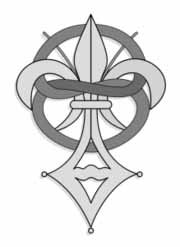
Priory of Zion
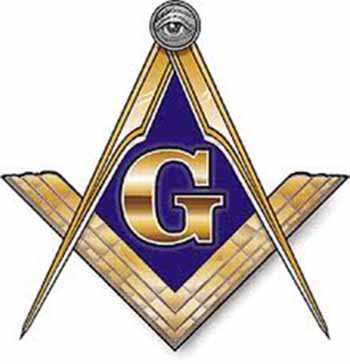
Freemasons
